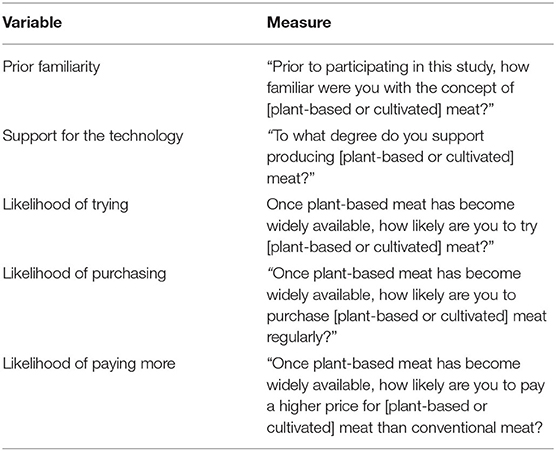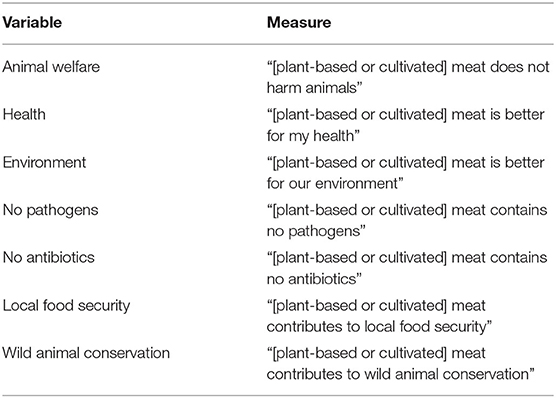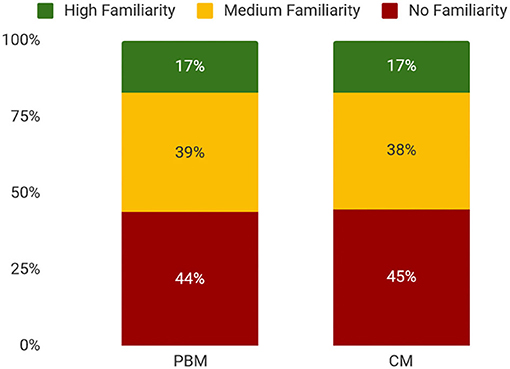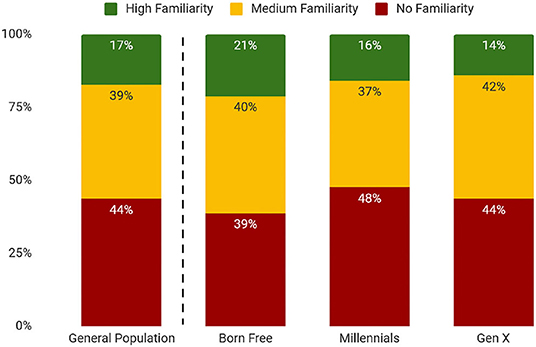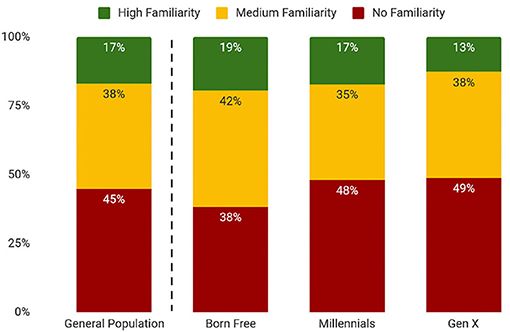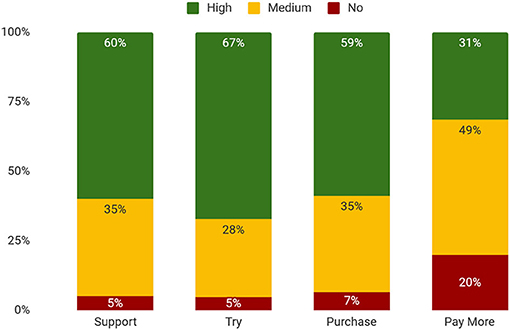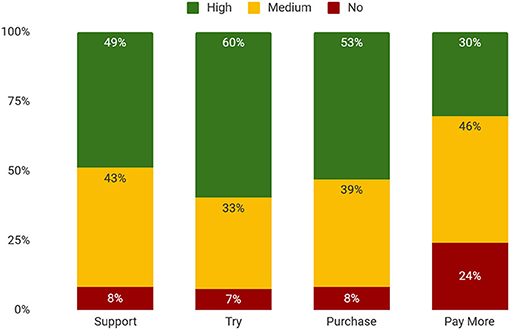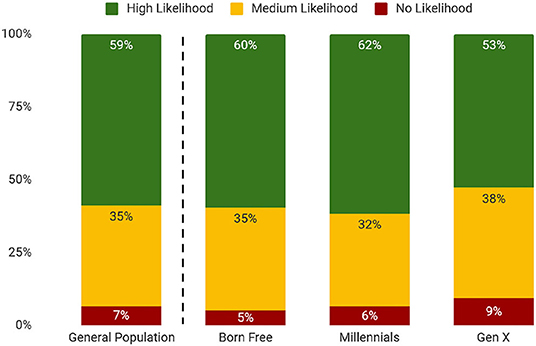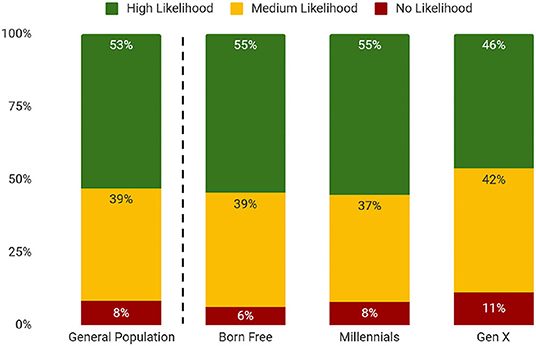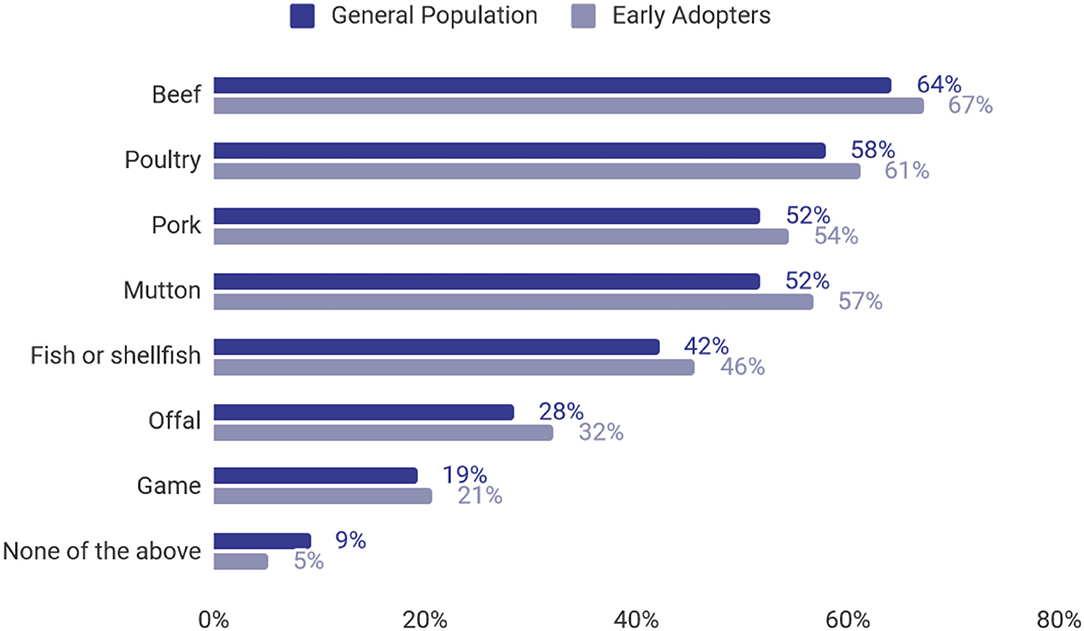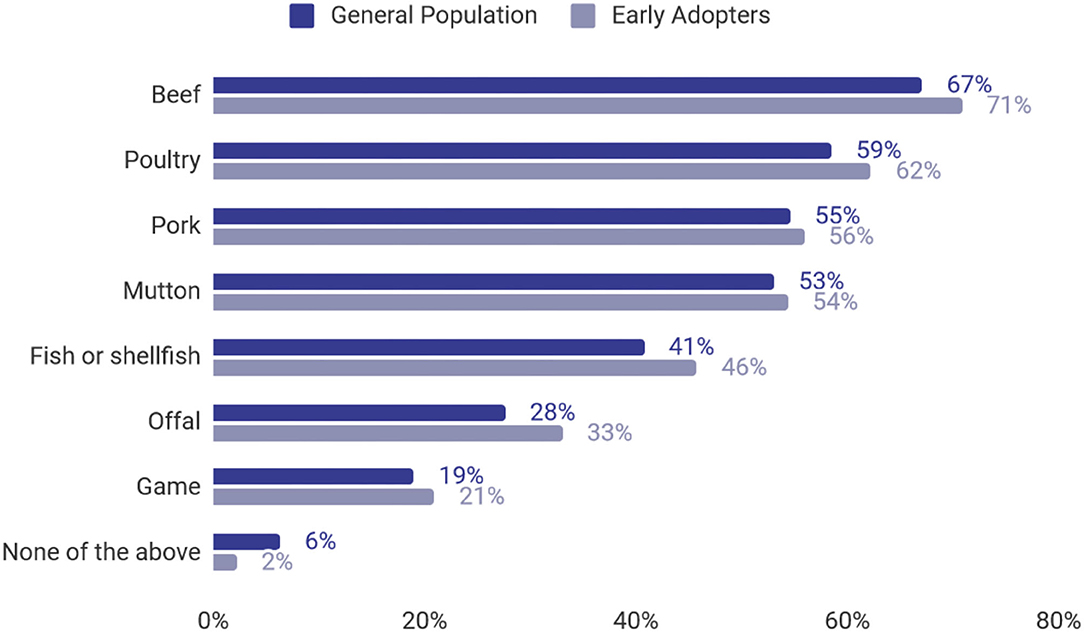- 1Communication Program, School of Social and Behavioral Sciences, Arizona State University, Glendale, AZ, United States
- 2Credence Institute, Stellenbosch, South Africa
The purpose of this study was to assess the likelihood of consumer adoption of plant-based and cultivated meat in South Africa as a pathway to a healthy, sustainable, and equitable food supply. We recruited a large sample of South Africans representative across age (18–61), gender, race, and income to participate in an online survey. Participants responded to a range of measures including adoption indicators, estimated yearly intake, motivators for purchasing, desired product characteristics, preferred species, and sociodemographics. We found a high degree of openness to both products. For plant-based meat, 67% were highly likely to try and 59% were highly likely to purchase. For cultivated meat, 60% were highly likely to try and 53% were highly likely to purchase. The highest acceptance was amongst the younger generations: 60% of born-frees, 62% of millennials, and 53% of Gen X were highly likely to purchase plant-based meat and 55% of born-frees, 55% of millennials, and 46% of Gen X were highly likely to purchase cultivated meat. For the general population, we observed that future meat intake was estimated to be split equally among the three meat categories (conventional, cultivated, and plant-based). We found early adopters (those highly likely to purchase) to be quite similar in attitudinal and sociodemographic characteristics in comparison to the general population. The study findings suggest that both plant-based and cultivated meat could be viable market-based options for improving the food system in South Africa, as consumers across all segments of society, and especially amongst the younger population, indicated broad acceptance.
Introduction
The African continent experiences the highest rates of food insecurity in the world (OECD-FAO, 2020). In South Africa, an estimated 43% of the total population experiences moderate or severe food insecurity and 62% cannot afford a healthy diet (OECD-FAO, 2020). Despite experiencing food insecurity, developing countries such as South Africa are projected to make up the vast majority of the total increase in global meat consumption, due to rapid population growth, rising income, and urbanization (Milford et al., 2019). Meat is a resource-intensive protein source (OECD-FAO, 2018, 2020), and increased demand for meat in developing countries is likely to place even more strain on an already stretched food system. In South Africa, meat consumption is already high, ranking 9th highest globally in per capita beef consumption and 11th highest in per capita poultry consumption (OECD-FAO, 2021). South Africa has an adult obesity rate of 28% (OECD-FAO, 2020) and a high burden of heart disease, so implementing food system solutions which aim to combat these diseases should be a public health priority (Puoane et al., 2002). These concurrent problems of (a) high food insecurity and (b) rising diet-related diseases associated with high meat consumption both make South Africa an ideal developing country for exploring market pathways to a more healthy, sustainable, and equitable protein supply.
Concentrated animal food production systems (CAFOs) produce meat cheaply; however, further intensification and expansion of these systems is not a sustainable solution, as they present numerous public health, environmental, and animal welfare concerns (Santo et al., 2020). In terms of public health, industrial meat production contributes to antibiotic resistance (Clark et al., 2020) and zoonotic disease (Centers for Disease Control Prevention, 2018; Espinosa and Treich, 2020); high meat consumption contributes to foodborne illness (Waters et al., 2011) and diet-related diseases including heart disease, type 2 diabetes, stroke, and certain cancers (Kaluza et al., 2012; Micha et al., 2012; IARC Working Group on the Evaluation of Carcinogenic Risks to Humans, 2018). In terms of the environment, meat production contributes to deforestation and biodiversity loss (Campbell et al., 2017), water and land use (Poore and Nemecek, 2018), Nutrient pollution (Campbell et al., 2017), and greenhouse gas emissions (Campbell et al., 2017). In addition, animals raised in confinement systems suffer both physically and mentally; conditions typically do not meet welfare principles such as ease of movement, absence of pain, comfort around nesting, absence of fear, and expression of social behavior (Pew Commission on Industrial Farm Animal Production, 2008). Accordingly, the OECD-FAO (2020) recommends developing and implementing alternative methods of producing meat and meat substitutes.
Promotion of culturally acceptable alternative protein sources may be one of the best available options to respond to the growing demand for meat. This may be particularly important in developing countries where consumers are generally reluctant to reduce their meat consumption (Chriki and Hocquette, 2020). Innovative foods like plant-based meat and cultivated meat have a smaller environmental footprint than conventionally farmed meat, yet have familiar sensory characteristics and fit within typical meal patterns (Tuomisto and Teixeira de Mattos, 2011).
Understanding the attributes of generations is important to consumer adoption in South Africa, with its relatively young population (United Nations Department of Economic Social Affairs, 2019). Generational differences have been found within adoption of emerging technologies such as the sharing economy (Hollowell et al., 2019); and also toward food, including for example, organic food purchasing (Kamenidou et al., 2020), morality beliefs toward meat consumption (Pribis et al., 2010), and cultivated meat specifically (Szejda et al., 2021). Because generational cohorts can share similar attitudes and purchasing behavior, segmentation by generation is an important strategy for both effective marketing (Dabija and Bǎbut, 2019) and understanding long-term adoption potential.
Plant-based meat is a relatively new type of food that is made entirely from plants and replicates the sensory experience of conventional meat. It is produced using protein sources such as soy, wheat, or pea protein isolates (fungi and lupin beans) amongst other plant-based ingredients (Santo et al., 2020). Producing meat substitutes from plants has a much smaller environmental impact compared to conventional meat (Heller and Keoleian, 2018). Plant-based meat has become widely available in South Africa over the last 5 years, with all major grocery retailers (Pick 'n Pay, Shoprite Checkers, SPAR, Woolworths) stocking local and international brands. With a wide variety of products available, the nutritional value of current plant-based meats varies considerably in terms of protein, fiber, saturated fat, and mineral content (Harnack et al., 2021). However, a randomized clinical trial found that consumption of plant-based meat products was beneficial to cardiovascular disease risk factors (Crimarco et al., 2020). New product development which considers a full set of factors including sensory properties, nutrition composition, and sustainability will be important for plant-based meat to reach its full potential as a food system solution.
Cultivated meat (also called cell-cultured, cultured, or lab-grown meat) is real animal meat produced without raising and slaughtering animals. Production begins with a small sample of starter cells, typically obtained from the muscle biopsy of an animal (George, 2020). These cells are transferred into a suitable medium and grown within a bioreactor that creates the conditions necessary for the growth and differentiation of stem cells into muscle and fat (Bhat et al., 2014). The bioreactor and medium provide nutrients, energy, and growth factors to the cells as they multiply (Bhat et al., 2014). Scaling production technology is still under development, but once produced at scale, cultivated meat promises to provide a protein source that uses fewer environmental resources and poses less public health risk than conventional meat (Landers et al., 2012; Tuomisto et al., 2014; Mattick et al., 2015; Smetana et al., 2015; Tuomisto, 2019; Chriki and Hocquette, 2020). Additionally, cultivated meat technologies are precise, creating the possibility of developing healthier and more nutritious products when compared to conventional meat, such as meat with higher omega fatty acid levels or lower saturated fat and cholesterol (Stout et al., 2020). At this time, cultivated meat is only available for purchase from one restaurant in Singapore. However several companies have opened pilot production facilities and greater availability to the public is expected between 2022–2025 (Bryant and Barnett, 2020; George, 2020).
The bulk of research conducted on consumer perceptions of plant-based and cultivated meat conducted to date has neglected emerging markets in developing countries, especially in the African continent. Numerous studies have been carried out in the United States and across multiple Asian and European countries, focusing on consumers' perceptions toward cultivated meat (see, for example, Verbeke et al., 2015; Hartmann and Siegrist, 2017; Wilks and Phillips, 2017; Bryant and Barnett, 2018; Stephens et al., 2018; Bryant and Dillard, 2019; Bryant et al., 2019; Chriki and Hocquette, 2020; Szejda et al., 2021). Similarly, multiple studies have investigated consumers' perceptions toward plant-based meat (Pohjolainen et al., 2015; Bryant, 2019; Parry and Szejda, 2019; Vainio, 2019; Dent, 2020; Faber et al., 2020; International Food Information Council, 2020; Leiserowitz et al., 2020). However, differing methodological approaches make the findings inconsistent and difficult to compare. Additionally, there is a need to conduct comparative research of consumers' perceptions toward plant-based and cultivated meat products (Bryant et al., 2019).
The production of meat via new technologies presents a potential solution to mitigating the externalities associated with conventional animal agriculture. In developing nations such as South Africa, plant-based and cultivated meat could contribute to a sustainable food system with greater accessibility to protein that is both healthy and familiar. However, the success of these new technologies will be highly dependent on their consumer adoption over time; currently, there is little known about consumer attitudes toward cultivated and plant-based meat in the African context.
In this applied study, we investigated the current level of familiarity with plant-based and cultivated meat, current level of acceptance of these products (as indicated by support for the technology, interest in trying, intention to purchase, and likelihood of paying more), motivations for purchasing, and the desired product characteristics that contribute to purchasing of these products. Finally, we examined sociodemographic characteristics of an early adopter segment (Rogers, 2003), defined in this study as those with a high purchase interest. The Diffusion of Innovation framework explains how innovations are adopted over time and segments a population into “innovators,” “early adopters,” “early majority,” and “laggards,” with each segment successively adopting an innovation over time (Rogers, 2003). The purpose of the present study was to generate data to understand consumer perceptions and market segmentation; to develop products that meet the needs of South African consumers; and to better understand the pathway for developing a healthy, sustainable, and equitable food supply in South Africa.
We divided our inquiries into three parts. The first set of research questions aimed to assess current familiarity and potential indicators of future adoption.
RQ1: Among the general population and generational segments, what is the current level of familiarity with plant-based and cultivated meat?
RQ2: Among the general population and generational segments, what is the current level of acceptance of plant-based and cultivated meat, as indicated by (a) the degree of support, (b) likelihood of trying, (c) likelihood of buying, and (d) likelihood of paying more?
The second set of research questions aimed to evaluate the factors which drive purchase intent of plant-based and cultivated meat and to examine the profile of early adopters of these meat types.
RQ3: What are the motivations of the general population and the early adopter segment to purchase plant-based and cultivated meat?
RQ4: What are the predictors of purchase intention for plant-based and cultivated meat?
RQ5: In comparison to the general population, what are the sociodemographic characteristics of early adopters of plant-based and cultivated meat?
The third set of research questions aimed to examine future consumption patterns that can inform priorities in research, development, and production.
RQ6: How does the general population and each generational segment envision they will diversify their sources of protein by the year 2030, in terms of proportion of plant-based, cultivated, and conventional products?
RQ7: For the general population and the early adopter segment, what are the desired characteristics of plant-based and cultivated meat products?
RQ8: For the general population and the early adopter segment, what are the desired species for plant-based and cultivated meat products?
Materials and Methods
Participants
We recruited an adult population ages 18–61 that was representative across age, gender, race, and income. The age range included born-frees (those who were born or grew up after the end of the Apartheid era; 18–27), millennials (28–41), and Gen X (42–61) generations, which matched the generational categories established by the South African government (Statistics South Africa, 2020). Additional inclusion criteria included: living in South Africa, passed at least one of two reading comprehension checks, and a nine-min duration minimum. The data were weighted in order to accurately reflect a representative sample of the South African population. The final sample size was 1,087 and the effective base was 959.
Procedures
This study received ethical clearance from the Arizona State Institutional Review Board (Study #00013176) prior to data collection. We used a South African data company, Nudge, to recruit participants. The survey was fielded in February 2021. Participants were recruited through social media ads and incentivized to take part in the study via a lucky draw approach. The ad mentioned a survey but did not refer to a specific topic. Participants were first screened to ensure they are residents of South Africa and at least 18 years of age. They were then given the option of completing the survey in English or isiZulu. While most South Africans understand English, isiZulu is the most widely spoken home language in South Africa (24%). The translation was conducted by isiZulu Translation, a South African translation service. Despite 22% of the participants considering isiZulu their home language, 98% of participants completed the survey in English. After selecting their preferred language, participants were presented with a consent form, which they could agree to by clicking “next” if they wished to participate in the survey.
The next two blocks of the survey focused on perceptions of plant-based and cultivated meat, which were presented in random order. Each section began with a short introduction about the respective product, followed by a comprehension test. Those who failed the first comprehension test were given a short explanation and prompted to try again, whereas those who failed both were removed from the study. The final section included sociodemographic questions.
Materials
Stimuli
There were three stimuli used in the study. The first stimulus was a short introductory text describing the challenges with rising population growth in South Africa, as well as the potential role of innovative food products in achieving food security. The second and third stimuli were placed at the beginning of the plant-based meat survey block and the cultivated meat survey block. These stimuli provided a short description of the applicable meat type. The plant-based meat stimulus described the products as being made entirely of plants; replicating the sensory experience of conventional meat; offering benefits to health, the environment, and animals; and becoming increasingly available over the next decade. The cultivated meat stimulus described the products as being the same as conventional meat in that it is made of animal cells but does not involve animal slaughter. The cultivated meat stimulus also included an explanation of the growing conditions in a bioreactor and included a short graphic describing the production process using a greenhouse analogy. We opted to use the term “cultivated meat” to describe the technology, as this term (as well as the term “cultured meat”) is a descriptive, non-advocacy term explicitly preferred by consumers (Szejda et al., 2021). The introductory text and plant-based and cultivated meat technology descriptions are available in the Supplementary Materials.
Measures
Questions related to familiarity and likelihood of adopting plant-based and cultivated meat were measured using single items (see Table 1). Answer choices were on a 5-point scale; 1 = not at all, 2 = somewhat, 3 = moderately, 4 = very, and 5 = extremely [familiar/supportive/likely]. For data analysis, we grouped the response options into three categories as follows: no (not at all), medium (somewhat and moderately), and high (very and extremely).
The importance of reasons for purchasing were measured using single items (see Table 2). Participants were asked, “If you were to consider purchasing [plant-based or cultivated] meat, how important to you are each of the following reasons?” Answer choices were on a 5-point scale (1 = not at all important, 5 = extremely important). For data analysis, we grouped scale items into three categories as follows: no (not at all), medium (somewhat and moderately), and high (very and extremely).
The importance of product characteristics were measured using single items. Participants were asked, “If you were to consider purchasing cultivated meat, how important to you are each of the following product characteristics?” The six product characteristics were phrased as follows: “taste,” “texture,” “easy to prepare,” “fits with my usual meals,” “provides same nutrition as conventional meat,” “provides better nutrition as conventional meat.” Answer choices were on a 5-point scale (1 = not at all important, 5 = extremely important). For data analysis, we grouped scale items into three categories as follows: no (not at all), medium (somewhat and moderately), and high (very and extremely).
The preferred species for plant-based and cultivated meat were indicated by selecting one or more options (beef, poultry, pork, mutton, fish or shellfish, offal, game). Yearly meat intake by meat type was assessed using a sliding scale in which participants could estimate the percentage that each meat category (conventional, cultivated, plant-based) would contribute to their overall meat consumption over the course of a year. Sociodemographic measures included: age, gender, race, religion, language, province, population density, political orientation, education level, income, occupation, and dietary patterns. The dietary measures included diet category (omnivore, pescatarian, vegetarian, or plant-based/vegan) and weekly meat consumption frequency. With the exception of the yearly meat intake and the sociodemographic measures, all questions were separately asked with regard to both plant-based and cultivated meat.
The dataset and questionnaire are available open access on Open Science Framework (osf.io/s3qw7).
Results
Part 1: Current Levels of Familiarity and Likelihood of Future Adoption
The first part of our analysis examines current levels of familiarity and likelihood of future adoption of plant-based and cultivated meat among the general South African population and by generational segments (born-frees, n = 373; millennials, n = 458, and Gen X, n = 256).
Familiarity
Familiarity with plant-based and cultivated meat was fairly low among the South African population. For plant-based meat, 17.3% of participants were highly (very or extremely) familiar. The pattern for cultivated meat was very similar, with 16.9% reporting high familiarity. Figure 1 illustrates the findings in detail.
In terms of generational differences, we observed the highest familiarity levels among born-frees, with 21.1% highly familiar with plant-based and 19.5% highly familiar with cultivated meat. In contrast, millennials and Gen X reported lower levels of familiarity, with 15.9% of millennials and 14.2% of Gen X being highly familiar with plant-based meat and 17.1% of millennials and 12.8% of Gen X being highly familiar with cultivated meat. See Figures 2, 3 for detailed comparisons across the generations.
Future Adoption Potential
Despite the generally low familiarity levels, likelihood of future adoption for plant-based and cultivated meat was high among the South African population. We reported future adoption for both meat types along four dimensions: degree of support, likelihood to try, likelihood to purchase, and likelihood to pay more. Future adoption levels were overall higher for plant-based meat in comparison to cultivated meat. For plant-based meat, 59.9% were highly supportive, 67.3% were highly likely to try, and 58.8% were highly likely to purchase. For cultivated meat, 48.9% were highly supportive, 59.6% were highly likely to try, and 53.0% were highly likely to purchase. The likelihood to pay more was substantially lower for both meat types: 31.5% of participants were highly likely to pay more for plant-based meat and 30.1% of participants were highly likely to pay more for cultivated meat. See Figures 4, 5 for more detail.
Next, we examined generational differences using the likelihood to purchase measure. Compared to Gen X, younger generations (born-frees and millennials) had higher levels of purchase intention for both meat types. For plant-based meat, 59.7% of born-frees, 61.6% of millennials, and 52.8% of Gen X were highly likely to purchase. For cultivated meat, 54.7% of born-frees, 55.3% of millennials, and 46.3% of Gen X were highly likely to purchase. Figures 6, 7 show the breakdowns per generation for both meat types in detail.
Similar generational trends could also be observed for the other future adoption measures for both plant-based and cultivated meat, with future adoption levels generally highest among born-frees and millennials. Generational differences for all key future adoption measures can be found in the Supplemental Materials.
Part 2: Early Adopters of Alternative Proteins
The second part of our analysis evaluated the factors which drive purchase intent of plant-based and cultivated meat and examined the profile of early adopters of these meat types. In our study, we defined early adopters as those who reported a high likelihood of purchasing plant-based meat (plant-based meat early adopters; n = 640) or cultivated meat (cultivated meat early adopters, n = 576).
Motivation for Purchasing
First, we examined the importance of different motivations for purchasing plant-based and cultivated meat. In Figures 8, 9 below, we compared the mean importance scores for each motivation between the general population and early adopters of the respective meat type. Overall, the general population found all motivations to be very important for both meat types, with all mean motivation ratings at least 3.8 (4 = very important). We observed the same pattern with early adopters, though the importance of each motivation was more salient overall, with all mean motivation ratings at least 4.1. For both meat types, the strongest motivating factors were animal welfare, health, the environment, and food security. See Figures 8, 9 for more detail.
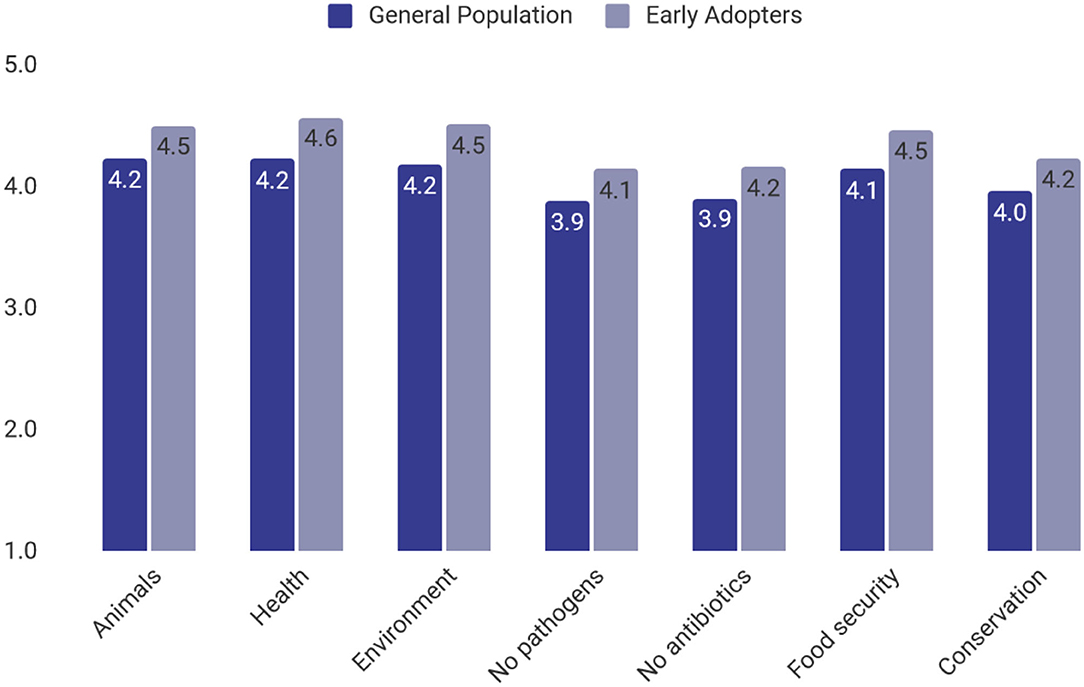
Figure 8. Mean importance of motivations for plant-based meat in the general population and among early adopters.
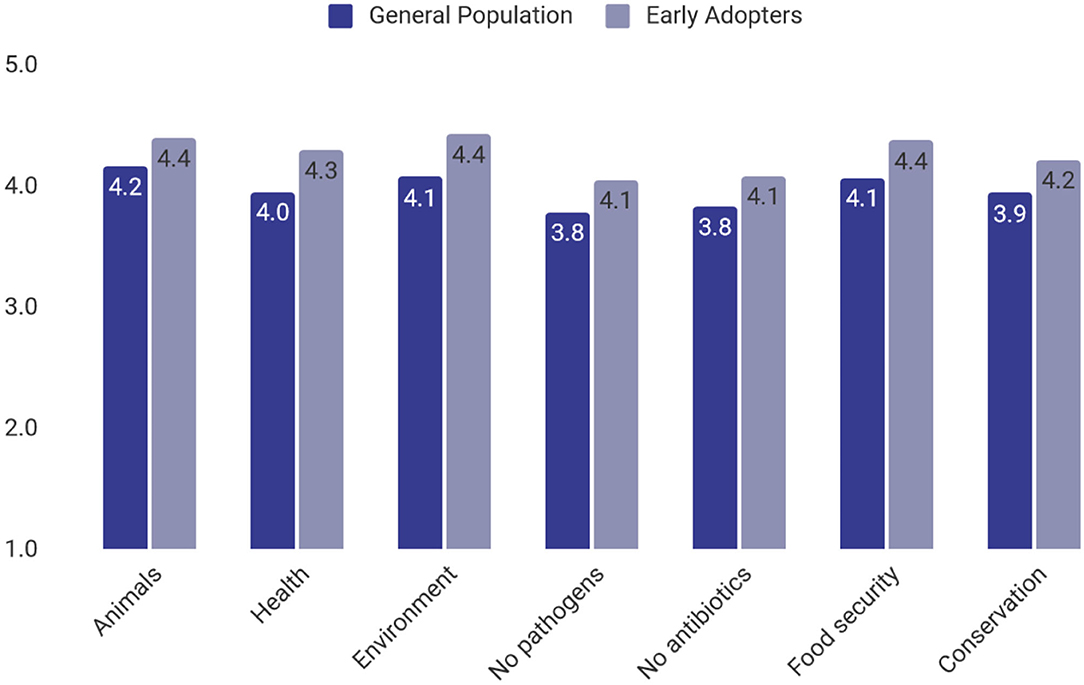
Figure 9. Mean importance of motivations for cultivated meat in the general population and among early adopters.
Predictors of Purchasing
Next, we assessed predictors of purchase intention by conducting regression analyses and by comparing the sociodemographic characteristics of early adopters to the general population.
First, we conducted two sets of multiple regression analyses using the forward method to identify the most predictive set of demographic and attitudinal predictors of purchase intention for both plant-based meat and cultivated meat. The dependent variable was likelihood of purchasing the relevant meat type (plant-based meat or cultivated meat). The predictor variables included prior familiarity with the relevant meat type (plant-based or cultivated meat), frequency of meat consumption, age, gender, political orientation, household income, education, and attitudinal factors. The attitudinal factors reflected the degree of importance of each reason for purchasing the relevant meat type (plant-based or cultivated meat) and included: does not harm animals, better for my health, better for our environment, contains no pathogens, contains no antibiotics, contributes to local food security, contributes to wild animal conservation.
For plant-based meat, the final model accounted for 35.9% of variance in purchase intention, F(5, 822) = 93.83, p < 0.001 and showed that prior familiarity (β = 0.23, t = 8.23, p < 0.001) and three attitudinal factors, “plant-based meat is better for my health (β = 0.23, t = 5.71, p < 0.001),” “plant-based meat contributes to local food security (β = 0.19, t = 4.98, p < 0.001),” and “plant-based meat is better for our environment (β = 0.18, t = 4.46, p < 0.001)” had a significant positive relationship with purchase intention, while household income (β = −0.06, t = −2.21, p = 0.027) had a negative relationship (lower income predicted higher purchase intention).
Similar results were found for cultivated meat, where the final model predicted 32.1% of the variance in purchase intention, F(5, 822) = 79.27, p < 0.001 and showed that prior familiarity (β = 0.25, t = 8.74, p < 0.001) and three attitudinal factors, “cultivated meat is better for my health (β = 0.20, t = 5.45, p < 0.001),” “cultivated meat contributes to local food security (β = 0.13, t = 3.41, p = 0.001),” and “cultivated meat is better for our environment (β = 0.21, t = 5.26, p < 0.001)” had a significant positive relationship with purchase intention, while household income (β = −0.09, t = −3.17, p = 0.002) had a negative relationship.
Next, we compared the sociodemographic characteristics of the early adopters to the general population including age, gender, race/ethnicity, religion, language, location, population density, political orientation, education level, income, occupational status, diet category, and meat consumption frequency. Generally, we found that the plant-based early adopters and the cultivated meat early adopters were quite similar to the general population. This was in line with our regression analysis, in which the only sociodemographic factor that predicted purchase intention was income, with a small effect size. Attitudinal, rather than sociodemographic factors, appear to be more influential. The Supplementary Materials contain data tables for the general population and the two early adopter segments.
Part 3: Product Development for an Equitable Future
The third part of our analysis examines future consumption patterns that can inform priorities in research and development as well as production.
Diversification of Protein Sources
First, participants were asked to roughly estimate the percentage that each meat category would contribute to their overall meat consumption over the course of a year, once plant-based and cultivated meat has become widely available and affordable. For the general population, we observed that future meat intake was estimated to be split rather equally among the three categories. Examining future intake per generation, this pattern stayed roughly the same for born-frees and millennials. However, Gen X estimated their consumption of conventional meat to be substantially higher and accordingly allocated smaller shares to the meat alternatives. Details can be seen in Figure 10.
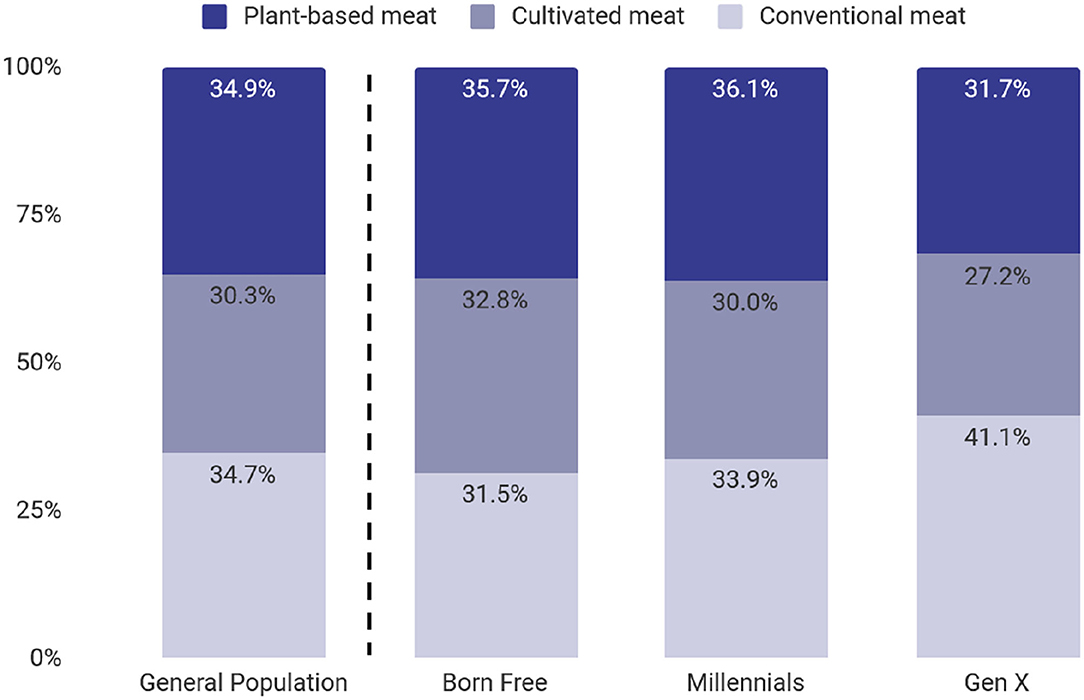
Figure 10. Estimated future intake of meat categories in the general population and by generations. Our questionnaire also allowed for the option of not eating any of these types of meat. However, in the analysis, we excluded this option (which made up roughly 5–6% of the estimated future intake) and recalibrated the percentages such that the shares of the three meat categories add up to 100%. This allowed for a more straightforward comparison of the estimated future intake of plant-based, cultivated and conventional meat.
Desired Products: Characteristics
Next we examined the importance of different product characteristics for participants' intention to purchase plant-based and cultivated meat. Below in Figures 11, 12, we report mean importance scores for both the general population and early adopters. Overall, the general population found all characteristics to be very important for both meat types, with all mean importance ratings at least 4.1 (4 = very important). The same pattern again occurred for the early adopters, though the importance was more salient overall, with all mean motivation ratings at least 4.3. For both meat alternatives, the most important characteristic was taste, followed by better nutrition.
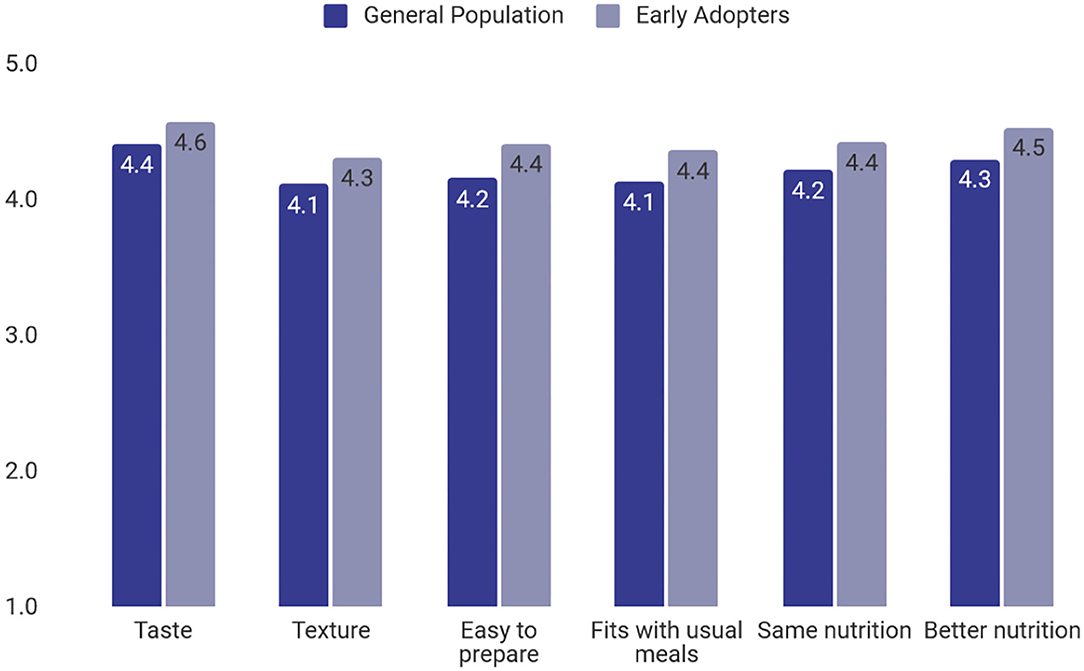
Figure 11. Mean importance of characteristics of plant-based meat in the general population and among early adopters.
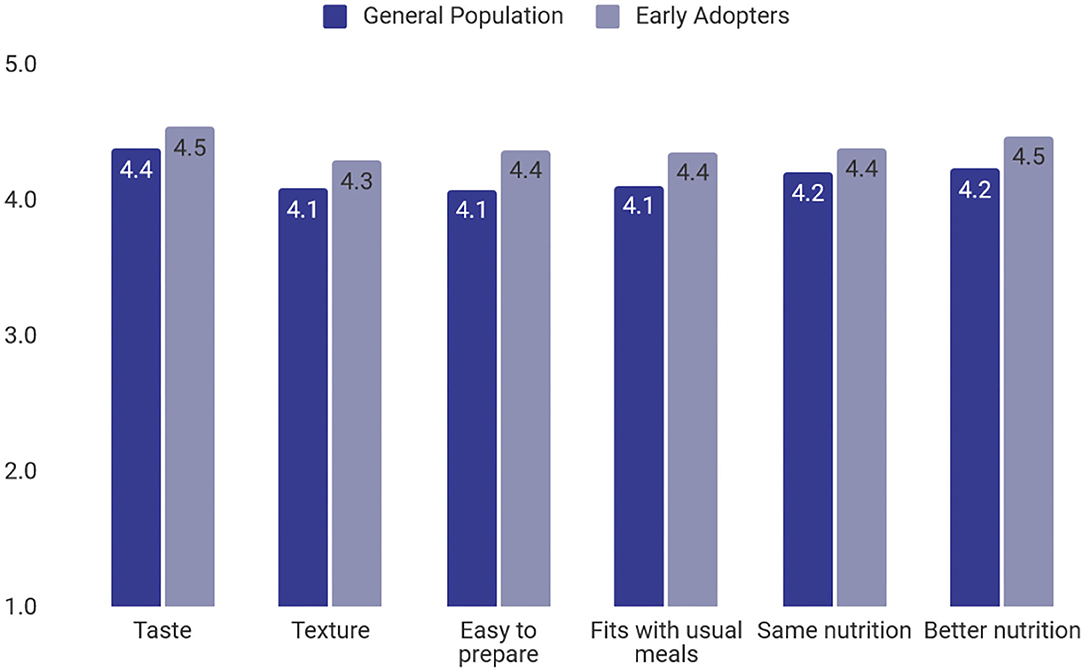
Figure 12. Mean importance of characteristics of cultivated meat in the general population and among early adopters.
Desired Products: Species
To understand desired product types, we analyzed participants' preferences for different species. The results for the two meat types were very similar, as can be seen in Figures 13, 14. Among the general population, for both plant-based and cultivated meat, beef and poultry were the most appealing product types, followed by pork and mutton. Fish, offal and game were less desired. Early adopters of the respective meat type reported higher levels of appeal for each type of meat, with their preferences following very similar patterns to those of the general population.
Discussion
The results of our study show that there is high interest in plant-based and cultivated meat among the South African population, indicating that the products are likely to be widely adopted. This is especially telling, since familiarity with these meat types is currently low, and prior familiarity has emerged as a top predictor of purchasing intention in this and other studies (e.g., Bryant et al., 2019; Weinrich et al., 2020). Populations within African nations are projected to dramatically rise over the next 30 years, suggesting both a need for food innovation and a market for producers (US Census Bureau, 2021).
To our knowledge, this study was the first of its kind to analyze consumer perceptions of plant-based and cultivated meat in Africa, providing an important benchmark and starting point for further studies across the continent. Further balancing the disproportionately Western-focused research with studies in developing and emerging markets thus is an important direction for future research. The generational trends we observed in future adoption levels support this point. With born-frees and millennials showing substantially higher levels of future adoption than Generation X, plant-based and cultivated meat will have a strong market in South Africa, with its relatively young population (United Nations Department of Economic Social Affairs, 2019). According to South Africa's 2021 midyear population estimates, 63% of the population is under 35 and the median age is 28 (Statistics South Africa, 2021). The comparably high share of younger generations in many emerging and developing countries thus suggests there might be strong markets for new meat types outside of the global North.
Additionally, these generational differences suggest there will be increasing adoptions over time with changing cohorts, which is especially pertinent given South Africa's young population (Statistics South Africa, 2021). This is in line with a recent generational assessment of US and UK consumers, in which younger generations showed the highest adoption potential (Szejda et al., 2021). Future adoption levels will also likely increase as alternative meat products become better-known and more widely available, since our regression analysis revealed prior familiarity to be the strongest predictor for purchase likelihood of both plant-based and cultivated meat.
Comparing the results between plant-based and cultivated meat, we see that future adoption levels among our participants are somewhat higher for plant-based meat across nearly all measures. Interestingly, when asking about the preference for different species or types of meat products, participants indicated a higher preference across almost all species for cultivated compared to plant-based meat. This seems contradictory to the adoption levels reported above, where plant-based meat was the more popular choice. However, this could be explained by the fact that it is less intuitive to imagine species when thinking about plant-based meat, as the products' ingredients are not related to the respective animal. This is different for cultivated meat, where cells are sourced from the desired species and it is easier for potential consumers to imagine a specific species-related product.
Regarding motivations for adopting plant-based and cultivated meat, we observe that all factors mentioned in the survey are important for consumers, not only the “big three” reasons typically cited in favor of veganism/vegetarianism, i.e., animals, environment and health (Janssen et al., 2016). In particular, local food security seems to be a strong motivator among South African consumers, though this finding should be taken with caution since the study introduced participants to the challenge of a rising population and the need for food security solutions. Comparing the motivations between plant-based and cultivated meat, we see strong similarities. However, health seems to be a slightly more important factor for adoption of plant-based meat. Although plant-based meat nutritional composition varies widely (Harnack et al., 2021), a 2020 clinical trial found improvements in cardiovascular risk factors in comparison to consumption of conventional meat (Crimarco et al., 2020). The nutritional composition of cultivated meat is still under development and could be either similar or improved in comparison to conventional meat (Stout et al., 2020). Given these differences, nutritional health claims may need to be product-specific. Overall consumers appear to be motivated by the multi-dimensional benefits of plant-based and cultivated meat, including both altruistic and personal benefits. This finding is consistent with cross country comparison studies, including a recent study comparing cultivated meat adoption in the US and UK (Szejda et al., 2021) and a study comparing plant-based and cultivated meat adoption in the US, China, and India (Bryant et al., 2019).
We observed these motivators to be more influential than demographic factors in predicting the likelihood of purchasing plant-based or cultivated meat. The demographic profiles of early adopters appear very similar to those of the general population. Only income emerged as a minor predictor of purchase intent in our regression analysis, with lower income levels being associated with higher purchase intention. This finding seems counterintuitive, but might be explained by the framing of these new meat types as a social equity solution in our questionnaire.
In general, we need to be mindful of the positive descriptions of plant-based and cultivated meat in our questionnaire, as those descriptions might have influenced participants toward more positive attitudes. Szejda et al. (2021) found that support for cultivated meat production increased with the inclusion of a longer educational text that described the production process and benefits. Further limitations of our results need to be acknowledged with regard to issues generally associated with self-report data. Next to cognitive restraints (e.g., poor recollection of past behavior and poor prediction of future behavior; Neuschatz et al., 2007; Poon et al., 2014), there might also be a social desirability bias in effect, leading to heightened positive results in terms of the attitudes toward plant-based and cultivated meat. Although demographically representative of the South African population, the sample is biased toward social media users due to study recruitment through social media ads.
Meat consumption is projected to rise dramatically in developing countries in accordance with their rising income and urbanization, which will exacerbate the health, environmental, and animal welfare problems associated with industrial animal farming. Developing nations will be increasingly challenged to address both undernourishment and obesity, but solutions must be viable and adopted by consumers in order to be successful. The study findings suggest that both plant-based meat and cultivated meat could be viable options for improving the food system in South Africa, as consumers across all segments of society, and especially amongst the younger population, indicated broad acceptance.
Data Availability Statement
The dataset can be accessed on Open Science Framework: https://osf.io/s3qw7/.
Ethics Statement
The study was approved by the Arizona State University IRB. The participants provided their written informed consent to participate in the study.
Author Contributions
CT, KS, and LR contributed to conception and design of the study. CT and LR managed the translation. KS submitted the IRB application. LR and KS managed the data collection. MS and KS analyzed the data. KS, CT, and MS wrote sections of the manuscript. All authors contributed to manuscript revision, read, and approved the submitted version.
Funding
This project was funded by a grant from the Animal Advocacy Research Fund at Animal Charity Evaluators, a non-profit organization that supports research to further understanding of effective animal advocacy. We are also grateful to Animal Charity Evaluators for their financial support.
Conflict of Interest
LR is an investor in Mzansi Meat Co., a South African start-up producing cultivated meat.
The remaining authors declare that the research was conducted in the absence of any commercial or financial relationships that could be construed as a potential conflict of interest.
Publisher's Note
All claims expressed in this article are solely those of the authors and do not necessarily represent those of their affiliated organizations, or those of the publisher, the editors and the reviewers. Any product that may be evaluated in this article, or claim that may be made by its manufacturer, is not guaranteed or endorsed by the publisher.
Acknowledgments
The authors wish to thank the team at Credence Institute, especially Angelique Lazarus, Andrea Marais, Brett Thompson, and Jay van der Walt for their help with study conceptualization and the grant proposal. Thank you also to Tessa Urbanovich for editing assistance and Yanqin Liu for assistance with statistical analyses.
Supplementary Material
The Supplementary Material for this article can be found online at: https://www.frontiersin.org/articles/10.3389/fsufs.2021.744199/full#supplementary-material
References
Bhat, Z. F., Bhat, H., and Pathak, V. (2014). “Prospects for in vitro cultured meat – A future harvest,” in Principles of Tissue Engineering, 4th Edn., eds R. Lanza, R. Langer, and J. Vacanti (Amstedam: Elsevier), 1663–1683.
Bryant, C., and Barnett, J. (2018). Consumer acceptance of cultured meat: a systematic review. Meat Sci. 143, 8–17. doi: 10.1016/j.meatsci.2018.04.008
Bryant, C., and Barnett, J. (2020). Consumer acceptance of cultured meat: an updated review (2018–2020). Appl. Sci. 10:5201. doi: 10.3390/app10155201
Bryant, C., and Dillard, C. (2019). The impact of framing on acceptance of cultured meat. Front. Nutr. 6:103. doi: 10.3389/fnut.2019.00103
Bryant, C., Szejda, K., Parekh, N., Desphande, V., and Tse, B. (2019). A survey of consumer perceptions of plant-based and clean meat in the USA, India, and China. Front. Sustain. Food Syst. 3:11. doi: 10.3389/fsufs.2019.00011
Bryant, C. J. (2019). We can't keep meating like this: attitudes towards vegetarian and vegan diets in the United Kingdom. Sustainability 11:6844. doi: 10.3390/su11236844
Campbell, B. M., Beare, D. J., Bennett, E. M., Hall-Spencer, J. M., Ingram, J. S., Jaramillo, F., et al. (2017). Agriculture production as a major driver of the earth system exceeding planetary boundaries. Ecol. Soc. 22:8. doi: 10.5751/ES-09595-220408
Centers for Disease Control Prevention (2018). Highly Pathogenic Asian Avian Influenza A(H5N1) Virus. Available online at: https://www.cdc.gov/flu/avianflu/h5n1-virus.htm (accessed December 12, 2018).
Chriki, S., and Hocquette, J. F. (2020). The myth of cultured meat: a review. Front. Nutr. 7:7. doi: 10.3389/fnut.2020.00007
Clark, M. A., Domingo, N. G., Colgan, K., Thakrar, S. K., Tilman, D., Lynch, J., et al. (2020). Global food system emissions could preclude achieving the 1.5 and 2°C climate change targets. Science 370, 705–708. doi: 10.1126/science.aba7357
Crimarco, A., Springfield, S., Petlura, C., Streaty, T., Cunanan, K., Lee, J., et al. (2020). A randomized crossover trial on the effect of plant-based compared with animal-based meat on trimethylamine-N-oxide and cardiovascular disease risk factors in generally healthy adults: Study with Appetizing Plantfood—Meat Eating Alternative Trial (SWAP-MEAT). Am. J. Clin. Nutr. 112, 1188–1199. doi: 10.1093/ajcn/nqaa203
Dabija, D. C., and Bǎbut, R. (2019). Enhancing apparel store patronage through retailers' attributes and sustainability. A generational approach. Sustainability 11:4532. doi: 10.3390/su11174532
Dent, M. (2020). Plant-Based and Cultured Meat 2020-2030. Cambridge: IDTechEx. Available online at: https://www.idtechex.com/en/research-report/plant-based-and-cultured-meat-2020-2030/702 (accessed July 13, 2021).
Espinosa, R., Tago, D., and Treich, N. (2020). Infectious diseases and meat production. Environ Resour Econ. 76, 1019–1044. doi: 10.1007/s10640-020-00484-3
Faber, I., Castellanos-Feijo, N. A., Van de Sompel, L., Davydova, A., and Perez-Cueto, F. J. A. (2020). Attitudes and knowledge towards plant-based diets of young adults across four European countries: exploratory survey. Appetite 145:104498. doi: 10.1016/j.appet.2019.104498
George, A. S. (2020). The development of lab-grown meat which will lead to the next farming revolution. Proteus 11, 1–25. doi: 10.37896/PJ11.07/001
Harnack, L., Mork, S., Valluri, S., Weber, C., Schmitz, K., Stevenson, J., et al. (2021). Nutrient composition of a selection of plant-based ground beef alternative products available in the United States. J. Acad. Nutr. Diet. doi: 10.1016/j.jand.2021.05.002. [Epub ahead of print].
Hartmann, C., and Siegrist, M. (2017). Consumer perception and behaviour regarding sustainable protein consumption: a systematic review. Trends Food Sci. Technol. 61, 11–25. doi: 10.1016/j.tifs.2016.12.006
Heller, M. C., and Keoleian, G. A. (2018). Beyond Meat's Beyond Burger Life Cycle Assessment: A Detailed Comparison Between a Plant-Based and an Animal-Based Protein Source. CSS Report, University of Michigan, Ann Arbor, Michigan. 1–38.
Hollowell, J. C., Rowland, Z., Kliestik, T., Kliestikova, J., and Dengov, V. V. (2019). Customer loyalty in the sharing economy platforms: how digital personal reputation and feedback systems facilitate interaction and trust between strangers. J. Self-Governance Manage. Econ. 7, 13–18. doi: 10.22381/J.S.M.E.7120192
IARC Working Group on the Evaluation of Carcinogenic Risks to Humans (2018). Red Meat and Processed Meat - Volume 114. Available online at: https://publications.iarc.fr/Book-And-Report-Series/Iarc-Monographs-On-The-Identification-Of-Carcinogenic-Hazards-To-Humans/Red-Meat-And-Processed-Meat-2018 (accessed July 13, 2021).
International Food Information Council (2020). A Consumer Survey on Plant Alternatives to Animal Meat. Available online at: https://foodinsight.org/wp-content/uploads/2020/01/IFIC-Plant-Alternative-to-Animal-Meat-Survey.pdf (accessed July 13, 2021).
Janssen, M., Busch, C., Rödiger, M., and Hamm, U. (2016). Motives of consumers following a vegan diet and their attitudes towards animal agriculture. Appetite 105, 643–651. doi: 10.1016/j.appet.2016.06.039
Kaluza, J., Wolk, A., and Larsson, S. C. (2012). Red meat consumption and risk of stroke: a meta-analysis of prospective studies. Stroke 43, 2556–2560. doi: 10.1161/STROKEAHA.112.663286
Kamenidou, I., Stavrianea, A., and Bara, E.-Z. (2020). Generational differences toward organic food behavior: Insights from five generational cohorts. Sustainability 12:2299. doi: 10.3390/su12062299
Landers, T. F., Cohen, B., Wittum, T. E., and Larson, E. L. (2012). A review of antibiotic use in food animals: perspective, policy, and potential. Public Health Rep. 127, 4–22. doi: 10.1177/003335491212700103
Leiserowitz, A., Ballew, M., Rosenthal, S., and Semaan, J. (2020). Climate Change and the American Diet. New Haven, CT: Yale Program on Climate Change Communication; Yale University and Earth Day Network. Available online at: https://climatecommunication.yale.edu/publications/climate-change-and-the-american-diet/ (accessed July 13, 2021).
Mattick, C. S., Landis, A. E., Allenby, B. R., and Genovese, N. J. (2015). Anticipatory life cycle analysis of in vitro biomass cultivation for cultured meat production in the United States. Environ. Sci. Technol. 49, 11941–11949. doi: 10.1021/acs.est.5b01614
Micha, R., Michas, G., and Mozaffarian, D. (2012). Unprocessed red and processed meats and risk of coronary artery disease and type 2 diabetes–An updated review of the evidence. Curr. Atheroscler. Rep. 14, 515–524. doi: 10.1007/s11883-012-0282-8
Milford, A. B., Le Mouël, C., Bodirsky, B. L., and Rolinski, S. (2019). Drivers of meat consumption. Appetite 141:104313. doi: 10.1016/j.appet.2019.06.005
Neuschatz, J. S., Lampinen, J. M., Toglia, M. P., Payne, D. G., and Cisneros, E. P. (2007). “False memory research: History, theory, and applied implications,” in The Handbook of Eyewitness Psychology, Vol. 1. Memory for Events, eds M. P. Toglia, J. D. Read, D. F. Ross, and R. C. L. Lindsay (Mahwah, NJ: Lawrence Erlbaum Associates Publishers), 239–260. Available online at: https://psycnet.apa.org/record/2006-22582-008
Organisation for Economic Co-operation and Development and Food and Agriculture Organization of the United Nations (2018). OECD-FAO Agricultural Outlook 2018-2027. Paris: OECD Publishing. doi: 10.1787/agr_outlook-2018-en
Organisation for Economic Co-operation and Development and Food and Agriculture Organization of the United Nations (2020). The State of Food Security and Nutrition in the World 2020. Transforming Food Systems for Affordable Healthy Diets. Rome: FAO.
Organisation for Economic Co-operation and Development and Food and Agriculture Organization of the United Nations (2021). OECD-FAO Agricultural Outlook 2021-2030. Paris: OECD Publishing.
Parry, J., and Szejda, K. (2019). How to Drive Plant-Based Food Purchasing: Key Findings From a Mindlab Study Into Implicit Perceptions of the Plant-Based Category. Research Report. Washington, DC: The Good Food Institute. Available online at: https://go.gfi.org/Mindlab-Strategic-Recommendations (accessed July 13, 2021).
Pew Commission on Industrial Farm Animal Production (2008). Putting Meat on the Table: Industrial Farm Animal Production in America. Baltimore, MD: Johns Hopkins Bloomberg School of Public Health. Available online at: http://www.pcifapia.org/_images/PCIFAPFin.pdf (accessed July 13, 2021).
Pohjolainen, P., Vinnari, M., and Jokinen, P. (2015). Consumers' perceived barriers to following a plant-based diet. Br. Food J. 117, 1150–1167. doi: 10.1108/BFJ-09-2013-0252
Poon, C. S. K., Koehler, D. J., and Buehler, R. (2014). On the psychology of self-prediction: consideration of situational barriers to intended actions. Judgment Decis. Making 9, 207–225. Available online at: https://EconPapers.repec.org/RePEc:jdm:journl:v:9:y:2014:i:3:p:207-225
Poore, J., and Nemecek, T. (2018). Reducing food's environmental impacts through producers and consumers. Science 360, 987–992. doi: 10.1126/science.aaq0216
Pribis, P., Pencak, R. C., and Grajales, T. (2010). Beliefs and attitudes toward vegetarian lifestyle across generations. Nutrients 2, 523–531. doi: 10.3390/nu2050523
Puoane, T., Steyn, K., Bradshaw, D., Laubscher, R., Fourie, J., Lambert, V., et al. (2002). Obesity in South Africa: the South African demographic and health survey. Obes. Res. 10, 1038–1048. doi: 10.1038/oby.2002.141
Santo, R., Kim, B., Goldman, S. E., Dutkiewicz, J., Biehl, E., Bloem, M. W., et al. (2020). Considering plant-based meat substitutes and cell-based meats: a public health and food systems perspective. Front. Sustain. Food Syst. 4:134. doi: 10.3389/fsufs.2020.00134
Smetana, S., Mathys, A., Knoch, A., and Heinz, V. (2015). Meat alternatives: life cycle assessment of most known meat substitutes. Int. J. Life Cycle Assess. 20, 1254–1267. doi: 10.1007/s11367-015-0931-6
Statistics South Africa (2020). Education Series Volume VI: Education and Labour Market Outcomes in South Africa, 2018 (Report no. 92-01-06). Pretoria: Statistics South Africa. Available online at: http://www.statssa.gov.za/publications/92-01-06/92-01-062018.pdf (accessed July 13, 2021).
Statistics South Africa (2021). Midyear Population Estimates, 2021. (Report no. P0302). Pretoria: Statistics South Africa. Available online at: http://www.statssa.gov.za/publications/P0302/P03022021.pdf
Stephens, N., Di Silvio, L., Dunsford, I., Ellis, M., Glencross, A., and Sexton, A. (2018). Bringing cultured meat to market: technical, socio-political, and regulatory challenges in cellular agriculture. Trends Food Sci. Technol. 78, 155–166. doi: 10.1016/j.tifs.2018.04.010
Stout, A. J., Mirliani, A. B., Soule-Albridge, E. L., Cohen, J. M., and Kaplan, D. L. (2020). Engineering carotenoid production in mammalian cells for nutritionally enhanced cell-cultured foods. Metab. Eng. 62, 126–137. doi: 10.1016/j.ymben.2020.07.011
Szejda, K., Bryant, C. J., and Urbanovich, T. (2021). US and UK consumer adoption of cultivated meat: a segmentation study. Foods 10:1050. doi: 10.3390/foods10051050
Tuomisto, H. L., Ellis, M. J., and Haastrup, P. (2014). “Environmental impacts of cultured meat: alternative production scenarios,” in 9th International Conference on Life Cycle Assessment in the Agri-Food Sector (San Francisco, CA). Available online at: https://core.ac.uk/download/pdf/38629617.pdf (accessed July 13, 2021).
Tuomisto, H. L., and Teixeira de Mattos, M. J. (2011). Environmental impacts of cultured meat production. Environ. Sci. Technol. 45, 6117–6123. doi: 10.1021/es200130u
United Nations Department of Economic Social Affairs (2019). 2019 Revision of World Population Prospects. Available online at: https://population.un.org/wpp (accessed July 13, 2021).
US Census Bureau (2021). International Data Base. Available online at: https://www.census.gov/programs-surveys/international-programs/about/idb.html (accessed July 13, 2021).
Vainio, A. (2019). How consumers of meat-based and plant-based diets attend to scientific and commercial information sources: eating motives, the need for cognition and ability to evaluate information. Appetite 138, 72–79. doi: 10.1016/j.appet.2019.03.017
Verbeke, W., Marcu, A., Rutsaert, P., Gaspar, R., Seibt, B., Fletcher, D., et al. (2015). 'Would you eat cultured meat?': consumers' reactions and attitude formation in Belgium, Portugal and the United Kingdom. Meat Sci. 102, 49–58. doi: 10.1016/j.meatsci.2014.11.013
Waters, A. E., Contente-Cuomo, T., Buchhagen, J., Liu, C. M., Watson, L., Pearce, K., et al. (2011). Multidrug-resistant Staphylococcus aureus in US meat and poultry. Clin. Infect. Dis. 52, 1227–1230. doi: 10.1093/cid/cir181
Weinrich, R., Strack, M., and Neugebauer, F. (2020). Consumer acceptance of cultured meat in Germany. Meat Sci. 162:107924. doi: 10.1016/j.meatsci.2019.107924
Keywords: plant-based meat, cultivated meat, cultured meat, cell-cultured meat, consumer acceptance, consumer adoption, South Africa, alternative protein
Citation: Szejda K, Stumpe M, Raal L and Tapscott CE (2021) South African Consumer Adoption of Plant-Based and Cultivated Meat: A Segmentation Study. Front. Sustain. Food Syst. 5:744199. doi: 10.3389/fsufs.2021.744199
Received: 19 July 2021; Accepted: 20 September 2021;
Published: 11 October 2021.
Edited by:
Celine Termote, Alliance Bioversity International and CIAT, FranceReviewed by:
Dan-Cristian Dabija, Babeș-Bolyai University, RomaniaChristopher John Bryant, University of Bath, United Kingdom
Copyright © 2021 Szejda, Stumpe, Raal and Tapscott. This is an open-access article distributed under the terms of the Creative Commons Attribution License (CC BY). The use, distribution or reproduction in other forums is permitted, provided the original author(s) and the copyright owner(s) are credited and that the original publication in this journal is cited, in accordance with accepted academic practice. No use, distribution or reproduction is permitted which does not comply with these terms.
*Correspondence: Keri Szejda, a2VyaS5zemVqZGFAYXN1LmVkdQ==
 Keri Szejda
Keri Szejda Moritz Stumpe
Moritz Stumpe Ludwig Raal
Ludwig Raal Claire E. Tapscott
Claire E. Tapscott